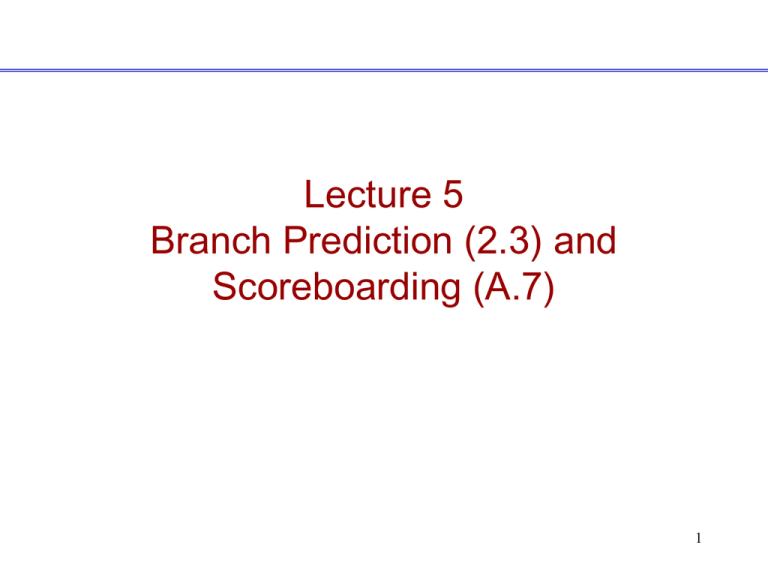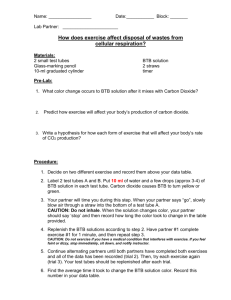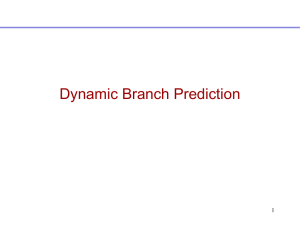
Lecture 5
Branch Prediction (2.3) and
Scoreboarding (A.7)
1
Why do we want to predict branches?
• MIPS based pipeline – 1 instruction issued per cycle, branch
hazard of 1 cycle.
– Delayed branch
• Modern processor and next generation – multiple instructions
issued per cycle, more branch hazard cycles will incur.
– Cost of branch misfetch goes up
– Pentium Pro – 3 instructions issued per cycle, 12+ cycle misfetch penalty
HUGE penalty for a misfetched path following a branch
2
Branch Prediction
• Easiest (static prediction)
–
–
–
–
Always taken, always not taken
Opcode/Profile based
Displacement based (forward not taken, backward taken)
Compiler directed (branch likely, branch not likely)
• Next easiest
– 1 bit predictor – remember last taken/not taken per branch
Use a branch-prediction buffer or branch-history table with 1 bit entry
Use part of the PC (low-order bits) to index buffer/table – Why?
– Multiple branches may share the same bit
Invert the bit if the prediction is wrong
Backward branches for loops will be mispredicted twice
EX: If a loop branches 9 times in a row and not taken once, what is the prediction accuracy?
Ans: Misprediction at the first loop and last loop => 80% prediction accuracy although branch is
taken 90% time.
3
2-bit Branch Prediction
• Has 4 states instead of 2, allowing for more information about
tendencies
• A prediction must miss twice before it is changed
• Good for backward branches of loops
4
Branch History Table
•
•
•
•
Has limited size
2 bits by N (e.g. 4K entries)
Uses low-order bits of branch PC to
choose entry
Plot misprediction instead of prediction
branch PC
BHT
01
5
Observations
• Prediction Accuracy ranges from 99% to 82% or a misprediction
rate of 1% to 18%
• Mis-prediction for integer programs (gcc, espresso, eqntott, li) is
substantially higher than FP programs (nasa7, matrix300,
tomcatv, doduc, spice, fppp)
• Branch penalty involves both mis-prediction rate and branch
frequency, and is higher for integer benchmarks
• Prediction accuracy improves with buffer size, but doesn’t
improve beyond 4K entries (Fig. C.20)
6
Figure C.20 Prediction accuracy of a 4096-entry 2-bit prediction buffer versus an infinite buffer for the SPEC89
benchmarks. Although these data are for an older version of a subset of the SPEC benchmarks, the results would be comparable for
newer versions with perhaps as many as 8K entries needed to match an infinite 2-bit predictor.
Copyright © 2011, Elsevier Inc. All
rights Reserved.
Correlating or Two-level Predictors
• Correlating branch predictors also look at other branches for clues.
Consider the following example.
if (aa==2) -- branch b1
aa = 0;
if (bb==2) --- branch b2
bb = 0;
if(aa!=bb) { … --- branch b3 – Clearly depends on the results of b1 and b2
If b1 is not taken and b2 is not taken, b3 will be taken. If prediction of b3 is
based only on its own history (instead of also those of b1 and b2), it is not an
accurate prediction.
(1,2) predictor – uses history of 1 branch and uses a 2-bit predictor
(m,n) predictor – uses the behavior of last m branches to choose from 2**m
branch predictors, each of which is an n-bit predictor for a single branch.
8
Correlating Branch Predictor
• If we use 2 branches as histories, then there are 4 possibilities
(T-T, T-NT, NT-NT, NT-T).
• For each possibility, we need to use a predictor (1-bit, 2-bit).
• And this repeats for every branch.
(2,2) branch prediction
9
Performance of Correlating Branch Prediction
• With 1024 entries, (2,2)
performs better than a
4096 entry noncorrelating 2-bit predictor.
• Outperforms a 2-bit
predictor with infinite
number of entries
10
Tournament Predictor
Adaptively combine local and global predictors – Ex. Two mispredictions before changing from local to global or vice versa
Mis-prediction in Tournament Predictor, Fig. 2.8
11
Branch Target Buffer (BTB)
BTB is a cache that contains the predicted PC value
instead of whether the branch will take place or not
(Ex. Loop address)
Is the current instruction a branch ?
• BTB provides the answer before the current instruction is decoded
and therefore enables fetching to begin after IF-stage .
What is the branch target ?
• BTB provides the branch target if the prediction is a taken direct
branch (for not taken branches the target is simply PC+4 ) .
12
BTB Fig. 2.22
BTB operations Fig. 2.23
• BTB hit, prediction taken → 0
cycle delay
• BTB hit, misprediction ≥ 2
cycle penalty – Correct BTB
• BTB miss, branch ≥ 1 cycle
penalty (Detected at the ID
stage and entered in BTB)
14
BTB Performance
• Two things can go wrong
– BTB miss (misfetch)
– Mispredicted a branch (mispredict)
• Suppose for branches, BTB hit rate of 85% and predict accuracy
of 90%, misfetch penalty of 2 cycles and mispredict penalty of 5
cycles. What is the average branch penalty?
2*(15%) + 5*(85%*10%)
• BTB and BPT can be used together to perform better prediction
15
Integrated Instruction Fetch Unit
Separate out IF from the pipeline and integrate with the following
components. So, the pipeline consists of Issue, Read, EX, and WB
(scoreboarding) ; Or Issue, EX and WB stages (Tomasulo).
1.
Integrated Branch Prediction – Branch predictor is part of the IFU.
2.
Instruction Prefetch – Fetch instn from IM ahead of PC with the help of
branch predictor and store in a prefetch buffer.
3.
Instruction Memory Access and Buffering - Keep on filling the Instruction
Queue independent of the execution => Decoupled Execution?
16
Branch Prediction Summary
• The better we predict, the higher penalty we might incur
• 2-bit predictors capture tendencies well
• Correlating predictors improve accuracy, particularly when
combined with 2-bit predictors
• Accurate branch prediction does no good if we don’t know there
was a branch to predict
• BTB identifies branches in IF stage
• BTB combined with branch prediction table identifies branches to
predict, and predicts them well
17
Instruction Level Parallelism
18
How to obtain CPI>1?
•
•
•
•
Issue more than one instruction per cycle
Compiler needs to do a good job in scheduling code (rearranging code
sequence) – statically scheduled
Fetch up to n instructions as an issue packet if issue width is n
Check hazards during issue stage (including decode)
– Issue checks are too complex to perform in one clock cycle
– Issue stage is split and pipelined
– Needs to check hazards within a packet, between two packets, among current
and all the earlier instructions in execution.
In effect an n-fold pipeline with complex issue logic and large set of bypass paths.
Type
Int. instruction
FP instruction
Int. instruction
FP instruction
Int. instruction
FP instruction
Pipe
Stages
IF
IF
ID
ID
IF
IF
EX
EX
ID
ID
IF
IF
MEM
MEM
EX
EX
ID
ID
WB
WB
MEM
MEM
EX
EX
WB
WB
MEM
MEM
WB
WB
19
HW Schemes: Instruction Parallelism
• Compiler or Static instruction scheduling can avoid some pipeline hazards.
– e.g. filling branch delay slot.
• Why in HW at run time?
– Works when can’t know dependence at compile time
WAW can only be detected at run time
– Compiler simpler
– Code for one machine runs well on another
• Key idea: Allow instructions behind stall to proceed
DIVD
ADDD
SUBD
F0,F2,F4
F10,F0,F8
F8,F8,F14
– Enables out-of-order execution => out-of-order completion
– But, both structural and data hazards are checked in MIPS
ADDD is stalled at ID, SUBD can not even proceed to ID.
20
HW Schemes: Instruction Parallelism
•
Out-of-order execution divides ID stage:
1.
2.
•
Issue—decode instructions, check for structural hazards, Issue in order if the functional unit
is free and no WAW.
Read operands (RO)—wait until no (RAW) data hazards, then read operands
ADDD would stall at RO, and SUBD could proceed with no stalls.
Scoreboards allow instruction to execute whenever 1 & 2 hold, not
waiting for prior instructions.
RO
EX1 … EXm WB – if no WAR
IF
ISSUE
RO
EX1 ………..EXn WB?
RO
EX1 ………….. EXp WB?
…
21
Scoreboard Implications
• Out-of-order completion => WAR, WAW hazards
• Solutions for WAR
– CDC 6600: Stall Write to allow Reads to take place; Read registers only during Read
Operands stage.
• For WAW, must detect hazard: stall in the Issue stage until other completes
• Need to have multiple instructions in execution phase => multiple execution units
or pipelined execution units
• Scoreboard replaces ID with 2 stages (Issue and RO)
• Scoreboard keeps track of dependencies, state or operations
– Monitors every change in the hardware.
– Determines when to read ops, when can execute, when can wb.
– Hazard detection and resolution is centralized.
22
Four Stages of Scoreboard Control
1. Issue—decode instructions & check for structural hazards (ID1)
If a functional unit for the instruction is free and no other active instruction has the same
destination register (WAW), the scoreboard issues the instruction to the functional unit and
updates its internal data structure. If a structural or WAW hazard exists, then the instruction
issue stalls, and no further instructions will issue until these hazards are cleared.
2. Read operands—wait until no data hazards, then read operands (ID2)
A source operand is available if no earlier issued active instruction is going to write it, or if the
register containing the operand is being written by a currently active functional unit. When the
source operands are available, the scoreboard tells the functional unit to proceed to read the
operands from the registers and begin execution. The scoreboard resolves RAW hazards
dynamically in this step, and instructions may be sent into execution out of order.
23
Four Stages of Scoreboard Control
3.Execution—operate on operands (EX)
The functional unit begins execution upon receiving operands. When the result is
ready, it notifies the scoreboard that it has completed execution.
4.Write result—finish execution (WB)
Once the scoreboard is aware that the functional unit has completed execution,
the scoreboard checks for WAR hazards. If none, it writes results. If WAR, then it
stalls the instruction.
Example:
DIVD F0,F2,F4
ADDD F10,F0,F8
SUBD F8,F8,F14
CDC 6600 scoreboard would stall SUBD until ADDD reads operands
CDC 6600 has one integer, 2 FP multipliers, 1 FP divide, 1 FP add units.
See Fig. A.50.
24
Scoreboard Example Cycle 7
Instruction status
Instruction
j
k Issue
LD
F6 34+ R2
1
LD
F2 45+ R3
5
MULTD F0 F2 F4
6
SUBD F8 F6 F2
7
DIVD
F10 F0 F6
ADDD F6 F8 F2
Functional unit status
TimeName Busy
Integer Yes
Mult1 Yes
Mult2 No
Add
Yes
Divide No
Register result status
Clock
F0
7
FU Mult
Read Execution Write
operands
complete Result
2
3
4
6
7
I3 stalled at read
because I2 isn’t
complete
dest
Op Fi
Load F2
Mult F0
S1 S2 FU for j FU for k Fj?
Fj Fk Qj
Qk
Rj
R3
F2 F4 Integer
No
Subd F8
F6 F2
Integer Yes No
F2
F4
Integer
F6 F8 F10
Add
F12
...
Fk?
Rk
No
Yes
F30
25
Three Parts of the Scoreboard
1. Instruction status—which of 4 steps the instruction is in
2. Functional unit status—Indicates the state of the functional unit (FU). 9 fields for each
functional unit
Busy—Indicates whether the unit is busy or not
Op—Operation to perform in the unit (e.g., + or –)
Fi—Destination register
Fj, Fk—Source-register numbers
Qj, Qk—Functional units producing source registers Fj, Fk
Rj, Rk—Flags indicating when Fj, Fk are ready and not yet read. Set to
No after operand are read.
3. Register result status—Indicates which functional unit will write each register, if one
exists. Blank when no pending instructions will write that register
26
27






